Rat turned ratcatcher: outsiders and authority in Gosnell & Ezquerra’s ‘Stainless Steel Rat’
24th August 2021
Long out of print, the adaptation of Harry Harrison’s science-fiction classic The Stainless Steel Rat by Kelvin Gosnell and Carlos Ezquerra is back in a gorgeous new edition!
Continuing our series of short essays commissioned from selected comics critics that explore 2000 AD and the Treasury of British Comics’ latest graphic novel collections, Ritesh Babu explores how Gosnell and Ezquerra’s adaptation of Harrison’s SF novels accentuates the conflicted anti-authoritarianism that spun out of the author’s own life.
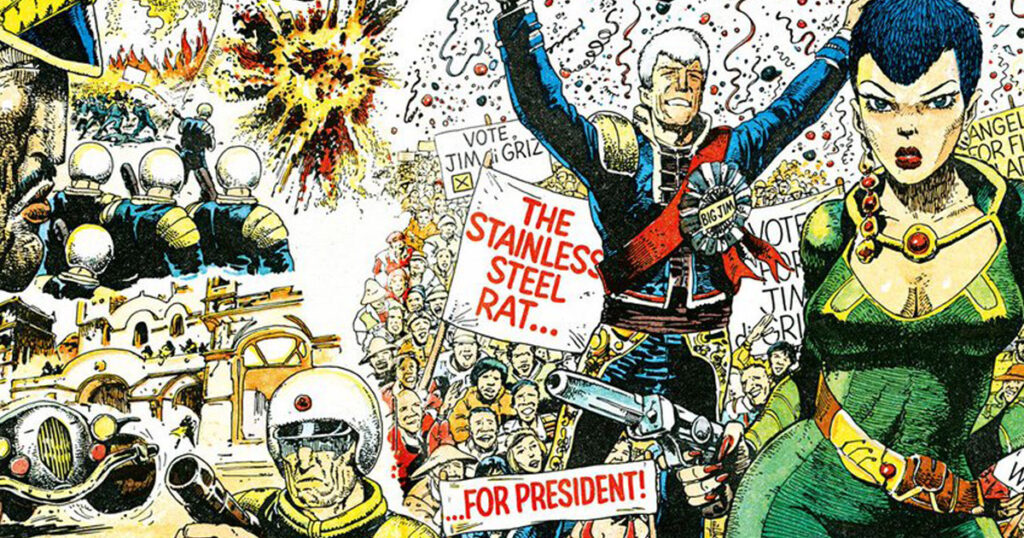
Terry Pratchett once remarked that it wasn’t Douglas Adams’ Hitchhiker’s Guide to the Galaxy that he found to be the funniest science-fiction novel ever published, but rather Harry Harrison’s Bill, The Galactic Hero. But one was a colossal success, while the other was not.
This, he noted, was because back when it was published in the mid-’60s, SF hadn’t become pervasive and established enough for the audience to ‘get’ what was being spoofed by Bill, The Galactic Hero. Harrison was taking the absolute piss out of Robert Heinlein and Starship Troopers, and the kind of poor SF it represented to him, but the audience wasn’t yet big enough to really catch all that by then for it to truly take off. Whereas by the time Hitchhiker’s hit in the late ’70s and early ‘80s, SF had been entrenched and familiarized enough that the jokes landed better.
This anecdote has long struck me as the perfect distillation of Harry Harrison as a creator. Never quite as big as those he was taking the piss out of, and the notable names that would come after him, but big enough to be prized among those who remembered. Not an overlooked genius, but certainly a treasured name among your favourite creators of old.
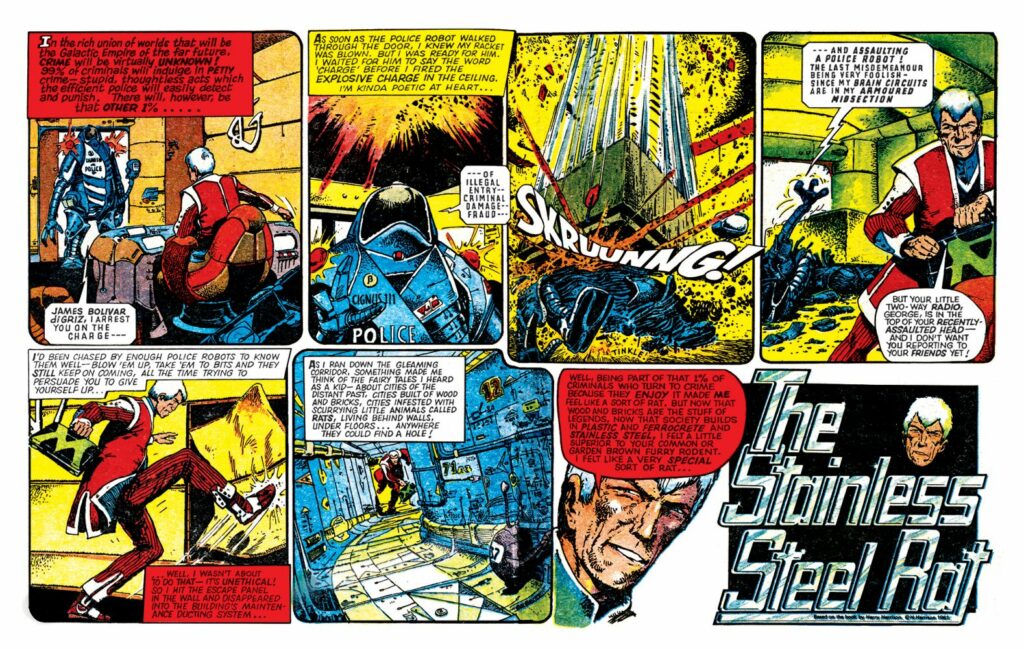
His most chronicled character, and arguably most personal creation, returns to print in graphic form with the new deluxe The Stainless Steel Rat, the legendary Kelvin Gosnell and the inimitable Carlos Ezquerra’s striking take on the novels. Adaptations like these, particularly with this caliber of talent, are not all too common in 2000 AD, and this is perhaps the cream of the crop, bathed in the aesthetics of the iconic artist who brought us into the world of Mega-City One.
It’s a classic of 2000 AD’s first ‘Golden Age’, produced in the late ‘70s and up to the mid-‘80s, adapting three of Harrison’s Stainless Steel Rat novels.
And sitting down with it now, in 2021, makes for a curious exercise. Stainless Steel Rat is very much defined by its tensions, the push-and-pull between things, and the contradictions that seem to be essential to his make-up. It’s a pulpy SF vision of the future, set thousands of years ahead where crime is largely minor, with 99% of it being ‘petty’ attempts which the police of the future will detect and stop. It’s a post-war society, wherein the last war took place over 5,000 years ago, and peace treaties signed since then have held up. There’s the sense of utopian outlook here, wherein the only crooks of note, that tricky 1%, are sneaky criminals driven not by seeming need, but pure thrills. The entire setup isn’t particularly new, and is inherited from Harrison’s predecessors. But it’s tempered with an adoration and fascination towards the outsider element who’d typically be the crooked antagonist to be arrested by the heroic lawman in such stories, to maintain balance.
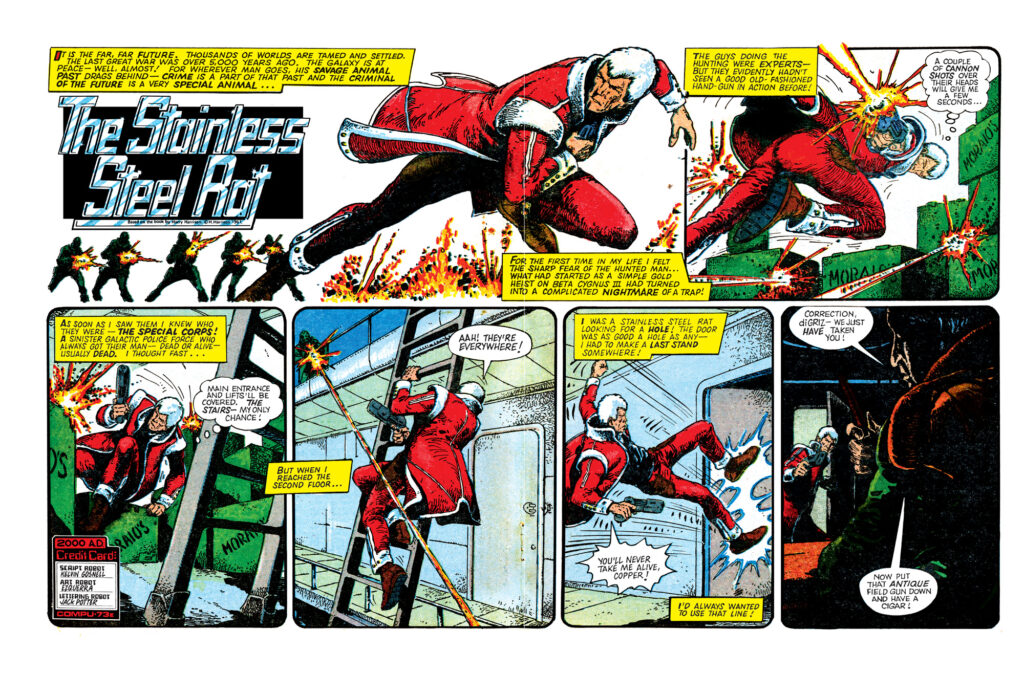
That’s what gets you James Bolivar diGriz, aka Slippery Jim, the gentleman thief and conman who resents authority, who loves the thrill of risk, and relishes the art of crime. He’s the man who could easily lose the police patrol on his tail, but keeps them just to screw with them. He values style above all else, and is a man whose morality prevents him from killing, even those who seek to kill him.
Things get interesting, however, when this rogue outsider is recruited by The Special Corps, the super-cops of the universe. The most highly effective agents and operators of the law, who almost have a mythic reputation, for none caught by them is ever seen again. The Criminal is now The Cop. Tellingly, The Special Corps is made up entirely of ex-criminals – the biggest crooks of the cosmos are now the cops. There’s something darkly funny about that, and that’s the kind of odd tension I mean when discussing this.
Harrison’s work had a tongue-in-cheek quality to it, almost always going for a laugh when possible, with these tensions being part of that comedy. The work feels married to and in conversation with that which has come before, the pulpy space opera pioneers of the past, which espoused a certain vision, whilst clearly having its own preference of the criminal element. So the choices feel like a strange attempt to marry these tensions and contradictions. The tension extends further, when you have the dynamic between Slippery Jim and Angelina, the femme fatale fated to be his eventual partner. Angelina will kill ruthlessly, while Jim cannot. They however marry. The ‘how’ of that, the how it all works out and plays, the messy gap and tension there, that’s where a lot of the work seems to exist.
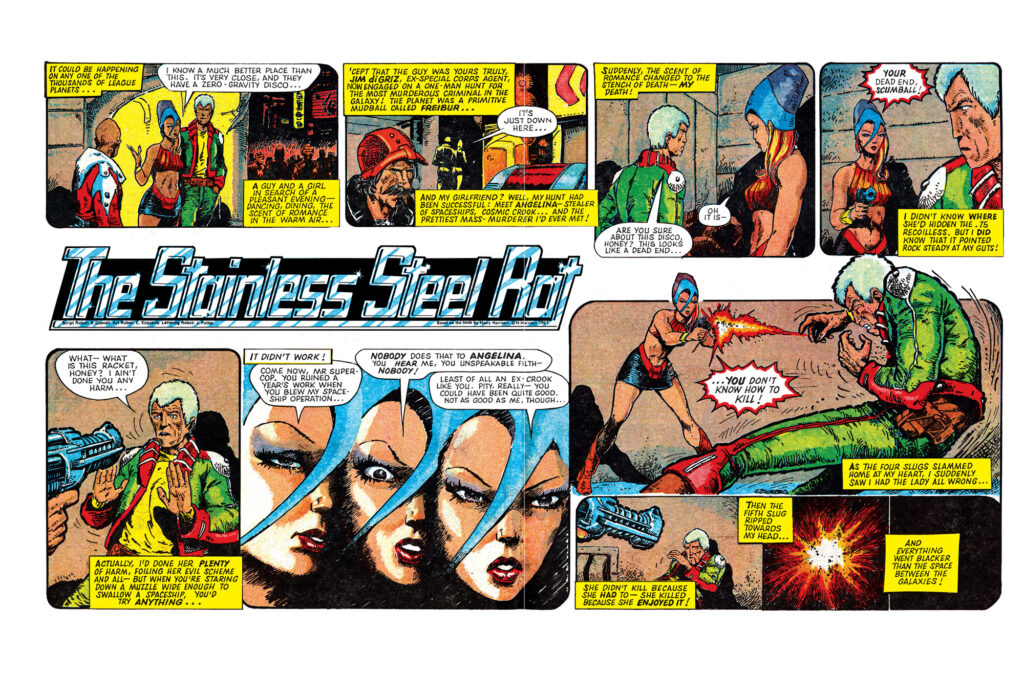
In a lot of ways, Stainless Steel Rat feels like the embodiment of Harrison’s own personal relationship to authority, power, and violence. He’d been drafted into the U.S Army Air Forces in the ‘40s during World War II, and he bloody hated it. He was dreadfully bored, but beyond that, he came to utterly loathe the military. But nevertheless, that doesn’t mean he could divorce himself from his own history, his own militarist past of being a military policeman. And that’s reflected in Jim diGriz, with an anti-authority figure forced to become a figure of said authority. One who gets out and escapes, and yet cannot outrun or erase that past, even as he goes from bachelor to a happy family man.
Across these pages, which span cosmic-trickery, Time-Wars, and election rigging in a fascist foreign land, it’s hard not to argue that Kelvin Gosnell and Carlos Ezquerra’s take on the material is perhaps the most interesting. Taken from the hands of its maker, and placed into the hands of these 2000 AD giants, it acquires a different flavour. The tension that underlies this world and the characters becomes more pronounced, the world itself much more openly dystopian under the pen of the man who helped imagine Judge Dredd.
The troubling elements and ideas of pulpy SF such as this, like Angelina’s mind-alterations, become even more horrific. What Harrison intended as big comedic punchlines acquire an additional layer, especially as Gosnell pairs down the novels with precision. The comedy clicks on the page between the deliveries of letterers Jack Potter and Pete Knight, who bridge Gosnell’s script with Ezquerra’s exquisite cartooning.
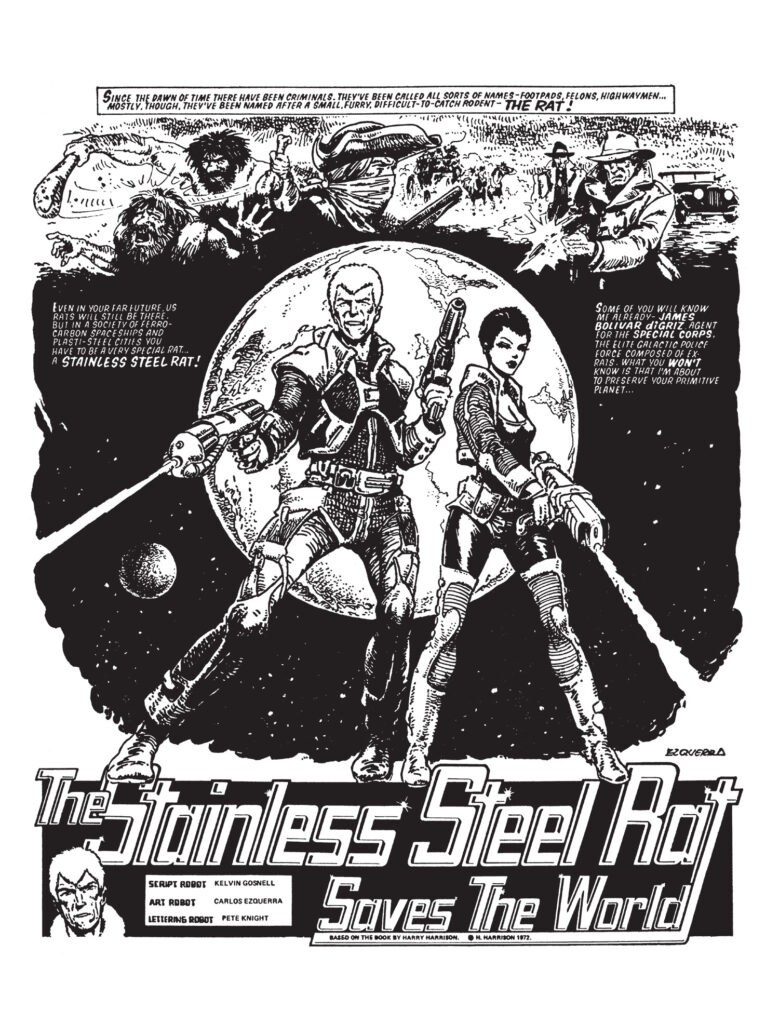
And never has the Stainless Steel Rat looked as exciting as he does here, under Ezquerra’s pen, with his visage modelled after actor James Coburn.
So return to this strange world, where the tension between things is palpable, where utopian and dystopian visions co-exist, wherein contradictions are the name of the game, and witness a classic of science-fiction and 2000 AD. Witness this fantasy of the outsider swallowed by the system to become the authority, for it still holds relevance.
Ritesh Babu is a freelance writer and comics critic whose work has appeared in outlets such as Panel x Panel, Shelfdust, ComicBookHerald, and many more. He has far too many thoughts on The British Invasion, and can be found obsessing over comics history over at @riteshwriter on Twitter.
All opinions expressed in this article are the author’s own and do not necessarily represent the opinions of Rebellion, its owners, or its employees.
